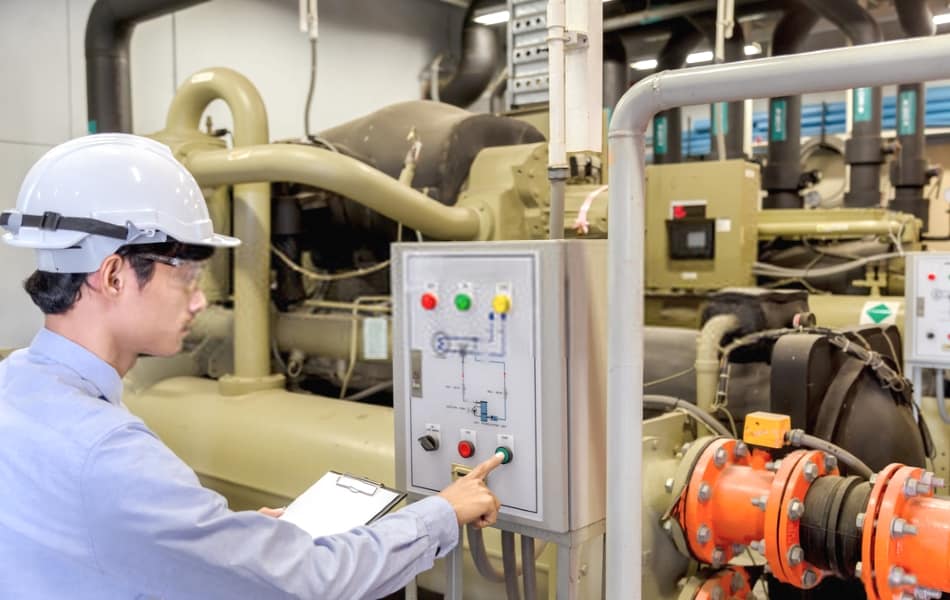Preserving Energy:
One of the biggest advantages that modern chiller systems have for the environment is how efficient they are with energy. A building’s total energy consumption can be substantially increased by traditional HVAC systems, which are known to be very energy-intensive. But newer chiller systems are engineered with cutting-edge innovation that makes the most efficient use of electricity.
- Variable Speed Drives (VSDs): Reduced energy loss is achieved by the use of variable speed drives (VSDs), which adapt the motor speed to meet the cooling demand. Reduced overall energy consumption is the result of chillers running at reduced rates during off-peak hours.
- Advanced Control Systems: Modern chillers have cutting-edge control systems that allow for real-time monitoring and adjustment of the system’s performance. For optimal performance under varied conditions, these systems optimize the chiller’s operation using algorithms.
- Heat Recovery: A few chiller systems are engineered to recover waste heat, which can then be put to use for other purposes, like heating water or rooms. As a result, less heating systems will be required, which helps to conserve energy.
Businesses save money on operational costs and power plants use less fossil fuels because chiller systems are more energy efficient. As a result, less carbon dioxide (CO2) and other dangerous emissions are emitted into the air.
Decreased Releases of Greenhouse Gases:
Because of their increased energy efficiency and usage of eco-friendly refrigerants, chiller systems play a major role in lowering emissions of greenhouse gases.
- Coolants that are Safe for the Environment: Hydrofluorocarbons (HFCs) and natural refrigerants have completely replaced ozone-depleting compounds like chlorofluorocarbons (CFCs) and hydrochlorofluorocarbons (HCFCs). These days, chillers are less stressful on the environment since they use refrigerants that have a lower GWP.
- Reduced Power Use: Reducing the burden on power plants, energy-efficient chillers use less electricity. A decrease in energy demand will lead to a decrease in carbon dioxide emissions, as a number of power plants continue to use fossil fuels to produce electricity.
- Carbon Footprint Reduction: Businesses can greatly lessen their impact on the environment by switching to chiller systems that use low-GWP refrigerants and cutting-edge energy-saving technology. Both legal requirements and international initiatives to reduce greenhouse gas emissions benefit from this.
Water Conservation:
Operating chiller systems can greatly affect water usage, which is a valuable resource. In order to reduce operational costs and have a positive impact on the environment, modern chiller technologies have reduced water consumption significantly.
- Closed-Loop Systems: Water is recirculated throughout many modern chiller systems, which are known as closed-loop systems. Over time, this saves a lot of water since it lowers water loss and reduces the need for frequent replenishing.
- Evaporative Cooling: To get the most out of their chiller systems while using the least amount of water possible, some implement evaporative cooling techniques. These systems are able to achieve effective cooling while conserving water by improving the evaporation process.
- Water Treatment and Reuse: One feature of modern chiller systems is the ability to treat the water used by the system and then reuse it. As a result, less fresh water intake is required, which is good for keeping water quality standards up.
The water conservation features of chiller systems contribute to more sustainable water management methods and less demand on local water resources. That is why it is so crucial in areas where shortages of water is a major problem.
Facilitation of Green Building Practices:
Green buildings, which aim to reduce their negative effects on the environment and increase their sustainability, cannot function without chiller systems. Building Research Establishment Environmental Assessment Method (BREEAM) and Leadership in Energy and Environmental Design (LEED) are two of various green building certification processes that can be strengthened by the incorporation of efficient chiller systems.
- Certification Program Energy Points: To get green building certifications, energy-efficient chiller systems are a must. More people will embrace sustainable behaviors since these certificates promote the usage of energy-efficient technology.
- Thermal Comfort and Air Quality: Consistent thermal comfort and high indoor air quality are essential components of green building standards, and modern chillers deliver both. Chiller systems improve the health and productivity of building occupants by maintaining a comfortable and healthy indoor climate.
- Integration with Renewable Energy Sources: Renewable energy sources, including solar or wind power, can be integrated with some cutting-edge chiller systems. The integration of renewable energy sources furthers the sustainability aims of green buildings by reducing reliance on non-renewable power sources.
- Lifecycle Sustainability: Using green building methods stresses how important it is to think about the whole span of building systems. Buildings may maintain their sustainability throughout their operational life with chiller systems that are built for long-term efficiency and minimum environmental impact.
Integration with Renewable Energy Sources:
Renewable energy sources, like solar, wind, and geothermal power, can be seamlessly integrated into modern chiller systems. Chilling systems may now run on renewable energy thanks to this integration, cutting down on the use of fossil fuels and helping the environment even more.
- Solar-Powered Chillers: Absorption chillers, which use the sun’s thermal energy to cool water, are one type of solar-powered chiller. Reducing energy costs and carbon emissions, solar-powered chillers offer a sustainable cooling solution by utilizing the power of sunlight.
- Wind-Powered Chillers: Traditional electric chillers can be powered by wind turbines, which allows chiller systems to run on sustainable wind energy. This integration lessens the impact of HVAC operations on the environment while simultaneously encouraging the use of clean energy.
Geothermal Heat Pumps: Pumps that draw heat or cold from the earth’s constant temperature are known as geothermal heat pumps. By harnessing geothermal energy, these systems provide an eco-friendly and effective way to cool spaces, cutting down on the need for traditional chiller systems that use non-renewable energy.


